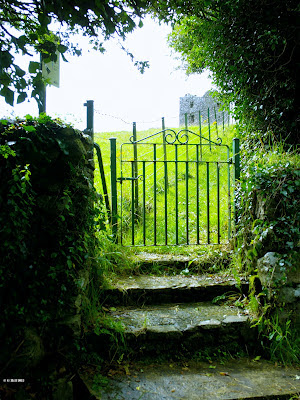Above Image: The entrance gate from the road
Below 4 Images: The interior
Above Image: The entrance door
Moyry Castle was built by Lord Mountjoy on elevated ground at the Moyry Pass in 1601. Mountjoy had recently engaged in a battle with the O'Neills of Ulster which eventually ended in a stalemate. The Moyry Pass also known as The Gap of the North was an ancient route between the provinces of Leinster and Ulster and so was a very strategic location to erect a defencive Tower and Bawn.
The Castle which stands three storeys high was surrounded by the aforementioned Bawn and had as defences a machiolation above the entrance door and gun loops in the walls. An unusual feature of this Castle are it's rounded walls. The Castle appears to have had rudimentary wooden floors with no evidence of stairs. This would lead one to believe that the floors were accessed by wooden ladders. It is thought that the Castle may not have been in use for very long and although the outer walls remain quite solid the interior is empty and the Bawn reduced to a small stretch about eight feet high which is located to the south east of the Tower.
Moyry is not difficult to reach. You will however have to drive down a by-road as it is a little off the beaten track. We manged to park outside the wall of a nearby house and walk back to the small iron gate that leads you into the Castle field. For a moment I stood and listened as there is the sound of a gurgling stream at this gate which when coupled with the vista of the ruins creates a very rustic and tranquil atmosphere.
A short walk up a grassy track leads you directly to the site. You can enter the Tower by the door facing you as you approach, but as mentioned it is just an empty shell inside. Partial remains of the Bawn sit adjacent and apparently this once square Bawn had the Tower situated at one of it's corners.
As you walk around the Tower you head down the hillock and this gives the ruins a far more imposing aspect. It is situated in a very scenic spot offering fine views that would have been in its time defensively crucial.
To find Moyry Castle, take the Junction 20 exit for Jonesborough from the N1 Dundalk to Belfast road. Drive through Jonesborough Village (B113) and take the first right hand turn at the Supermarket. A few yards on turn left onto the Kilnasaggart road. This road becomes quite narrow in places and you will need to drive approx. 2KM until you reach a fork in the road. Turn left and about 50 metres later you will see a small iron gate on your right. You can park a few metres further on near a house and just walk back toward the gate.















































